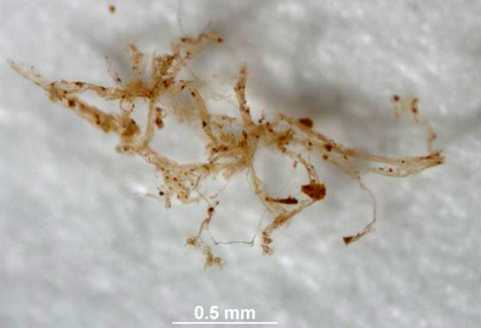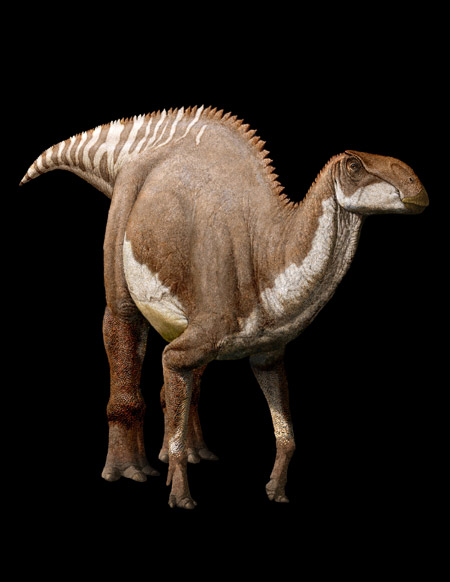Duck-billed Dinosaur Blood Described in New Paper
Researchers Discovery Mineralised Blood Vessels in 80 Million-Year-Old Dinosaur
Stories of dinosaur soft tissue discoveries are becoming relatively common. The unprecedented power of some of the very latest analytical tools are provided palaeontologists and other researchers with remarkable insights into the lives of the Dinosauria and other extinct creatures. Once upon a time, the concept of a “dinosaur biologist” was just a pipe dream, but being able to study the biology of non-avian dinosaurs is becoming a distinct possibility.
American scientists including researchers from North Carolina State University and the University of Texas (Austin, Texas) have published details of the discovery of mineralised blood vessels preserved within the fossils of a duck-billed dinosaur – Brachylophosaurus canadensis.
A paper detailing the research “Timothy P. Cleland et al. Mass Spectrometry and Antibody-Based Characterization of Blood Vessels from Brachylophosaurus canadensis”, has just been published in the “Journal of Proteome Research”.
Blood Vessels from the Demineralised Fossilised Bones of a Duck-billed Dinosaur (B. canadensis)
Picture credit: Mary Schweitzer, North Carolina State University
Dinosaur Blood
Mary Schweitzer, one of the authors of the paper, is a leading authority on the identification of potential soft tissue remains in the fossils of extinct species. In 2007, she was one of a group of scientists that published a paper detailing the discovery of soft tissue remains within the sixty-eight-million-year-old fossilised femur of a Hell Creek tyrannosaur. Dr Schweitzer, formerly based in Montana is the Research Curator (palaeontology) at the North Carolina Museum of Sciences, part of North Carolina State University.
To read two articles related to the Dr Schweitzer’s research: The Hunt for Dinosaur DNA and also: Ancient Mosquito Fossil with its Victim’s Blood.
The leader of the research, Dr Tim Cleland (University of Texas) commented:
“This study is the first direct analysis of blood vessels from an extinct organism and provides us with an opportunity to understand what kinds of proteins and tissues can persist and how they change during fossilisation.”
Brachylophosaurus canadensis – Contribution to the Advancement of Science
Thanks to the extensive fossil material associated with this Late Cretaceous hadrosaur, scientists have been able to gain a great deal of information about this particular member of the Dinosauria. For example, a superbly well-preserved specimen allowed palaeontologists to identify dinosaur stomach contents, other specimens have contributed to our understanding of the radiation and evolution of duck-billed dinosaurs and in 2009, a team of American researchers found evidence of proteins in the femur of a Brachylophosaurus: Dinosaur Femur Reveals Dinosaur Proteins.
An Illustration of the Duck-billed Dinosaur Brachylophosaurus canadensis
Picture credit: Houston Museum of Natural Science
Structures Resembling Blood Vessels
Structures which resembled blood vessels have been recovered before from fossil dinosaur bones after removal of the mineral material (demineralisation). In this study, the research team set about testing these structures to see if they were likely to be endogenous to the bone (belonging to Brachylophosaurus) or whether such structures were the result of bacteria colonising the empty spaces in the bone after the original organic components had rotted away.
Using high-resolution mass spectrometry and an immunofluorescence study the scientists found two lines of evidence to support the idea that these structures did originate from the dinosaur and that they represent components of the blood vascular system. Firstly, peptide sequencing of the extracts from the bone proved to be consistent with peptides from extant archosaurian blood vessels (ostrich and chickens). Secondly, proteins identified by the mass spectrometry assessment could be localised to the tissues using antibodies specific to these proteins.
One of the proteins identified was myosin, it is found in the smooth muscles associated with the lining of blood vessels. The scientists report that:
“When all data are taken into consideration, the most parsimonious explanation is that these vessels, derived from demineralised dinosaur bone, are endogenous.”
Outlining the implications for this research, Dr Cleland explained:
“This will provide new avenues for pursuing questions regarding the evolutionary relationships of extinct organisms, and will identify significant protein modifications and when they might have arisen in these lineages.”
Visit Everything Dinosaur’s website: Everything Dinosaur.



